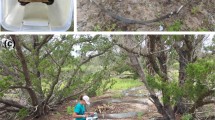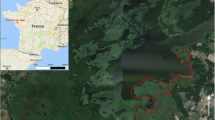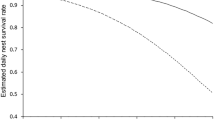Abstract
In birds, the characteristics of the nest site may affect reproductive success. We found that shelter is an important characteristic of the Antarctic petrel (Thalassoica antarctica) nests because shelter prevents chick predation. However, the benefit of shelter was countervailed by melt water which mainly entered well-sheltered nests. Chick survival was monitored until the chick was left unattended for the first time. Late-hatched chicks had a higher survival probability than early-hatched chicks, possibly because late hatchers swamp the predator, the south polar skua (Catharacta maccormicki). Poorly sheltered nests tended to be occupied by parents with low body mass and late-hatched eggs. The results suggest that both shelter per se and parental characteristics may explain the relationship between predation risk and shelter. We need experiments to study the influence of nest site on reproductive success, and we need to map the frequency of melt water as a cause of reproductive failure.




Similar content being viewed by others
References
Allison PD (1999) Logistic regression using the SAS system: theory and application. SAS Institute Inc., Cary, NC
Barbosa A, Moreno J, Potti J, Merino S (1997) Breeding group size, nest position and breeding success in the chinstrap penguin. Polar Biol 18:410–414
Boulinier T, Danchin E (1997) The use of conspecific reproductive success for breeding patch selection in terrestrial migratory species. Evol Ecol 11:505–517
Brooke MD, Keith D, Røv N (1999) Exploitation of inland-breeding Antarctic petrels by south polar skuas. Oecologia 121:25–31
Brouwer A, Spaans AL, Dewit AAN (1995) Survival of herring gull Larus argentatus chicks: an experimental analysis of the need for early breeding. Ibis 137:272–278
Burnham KP, Anderson DR (1992) Data-based selection of an appropriate biological model: the key to modern data analysis. In: McCullough DR, Barrett RT (eds) Wildlife 2001: populations. Elsevier, London, pp 16–30
Clark RG, Shutler D (1999) Avian habitat selection: pattern from process in nest-site use by ducks? Ecology 80:272–287
Coulson JC (1968) Differences in quality of birds nesting in centre and on edges of a colony. Nature 217:478–479
Danchin E, Boulinier T, Massot M (1998) Conspecific reproductive success and breeding habitat selection: implications for the study of coloniality. Ecology 79:2415–2428
Falk K, Møller S (1997) Breeding ecology of the fulmar Fulmarus glacialis and the kittiwake Rissa tridactyla in high-arctic northeastern Greenland, 1993. Ibis 139:270–281
Haftorn S, Bech C, Mehlum F (1991a) Aspects of the breeding biology of the Antarctic petrel Thalassoica antarctica and the krill requirement of the chicks, at Svarthamaren in Mühlig-Hofmannfjella, Dronning Maud Land. Fauna Norv Ser C 14:7–22
Haftorn S, Bech C, Mehlum F (1991b) Notes on the south polar skua Catharacta maccormicki breeding at Svarthamaren in Mühlig-Hofmannfjella, Dronning Maud Land. Fauna Norv Ser C 14:47–48
Hatch SA (1990) Individual variation in behavior and breeding success of northern fulmars. Auk 107:750–755
Hudson PJ (1982) Nest site characteristics and breeding success in the razorbill Alca torda. Ibis 124:355–359
Ims RA (1990) On the adaptive value of reproductive synchrony as a predator-swamping strategy. Am Nat 136:485–498
Kokko H, Harris MP, Wanless S (2004) Competition for breeding sites and site-dependent population regulation in a highly colonial seabird, the common guillemot Uria aalge. J Anim Ecol 73:367–376
Lorentsen SH (1996) Regulation of food provisioning in the Antarctic petrel Thalassoica antarctica. J Anim Ecol 65:381–388
Lorentsen SH, Røv N (1995) Incubation and brooding performance of the Antarctic petrel Thalassoica antarctica at Svarthamaren, Dronning Maud Land. Ibis 137:345–351
Mehlum F, Gjessing Y, Haftorn S, Bech C (1988) Census of the breeding Antarctic petrels Thalassoica antarctica and physical features of the breeding colony at Svarthamaren, Dronning Maud Land, with notes on breeding snow petrels Pagodroma nivea and south polar skuas Catharacta maccormicki. Polar Res 6:1–9
Moreno J, Barbosa A, Potti J, Merino S (1997) The effects of hatching date and parental quality on chick growth and creching age in the chinstrap penguin (Pygoscelis antarctica): a field experiment. Auk 114:47–54
Nilsson JÅ (1999) Fitness consequences of timing of reproduction. In: Adams NJ, Slotow RH (eds) Proceedings of the 22nd International Ornithology Congress. BirdLife South Africa, Johannesburg, pp 234–247
Ollason JC, Dunnet GM (1978) Age, experience and other factors affecting breeding success of the fulmar, Fulmarus glacialis, in Orkney. J Anim Ecol 47:961–976
Porter JM (1990) Patterns of recruitment to the breeding group in the kittiwake Rissa tridactyla. Anim Behav 40:350–360
Potts GR, Coulson JC, Deans IR (1980) Population dynamics and breeding success of the shag, Phalacrocorax aristotelis, on the Farne Islands, Northumberland. J Anim Ecol 49:465–484
R Development Core Team (2004) R: a language and environment for statistical computing. R Foundation for Statistical Computing, Vienna, Austria
Regehr HM, Rodway MS, Montevecchi WA (1998) Antipredator benefits of nest-site selection in black-legged kittiwakes. Can J Zool 76:910–915
Ricklefs RE (1969) An analysis of nesting mortality in birds. Smithson Contrib Zool 9:1–48
Rodway MS, Regehr HM (1999) Habitat selection and reproduction performance of food-stressed herring gulls. Condor 101:566–576
Rowe S, Jones IL (2000) The enigma of razorbill Alca torda breeding site selection: adaptation to a variable environment? Ibis 142:324–327
Sæther BE, Lorentsen SH, Tveraa T, Andersen R, Pedersen HC (1997) Size-dependent variation in reproductive success of a long-lived seabird, the Antarctic petrel (Thalassoica antarctica). Auk 114:333–340
SAS Institute Inc. (1990) SAS/STAT user’s guide: statistics. SAS Institute Inc, Cary, NC
Spear L, Nur N (1994) Brood size, hatching order and hatching date: effects on four life-history stages from hatching to recruitment in western gulls. J Anim Ecol 63:283–298
Stokes DL, Boersma PD (1998) Nest-site characteristics and reproductive success in Magellanic penguins (Spheniscus magellanicus). Auk 115:34–49
Tveraa T, Lorentsen SH, Sæther BE (1997) Regulation of foraging trips and costs of incubation shifts in the Antarctic petrel (Thalassoica antarctica). Behav Ecol 8:465–469
Tveraa T, Sæther BE, Aanes R, Erikstad KE (1998a) Body mass and parental decisions in the Antarctic petrel Thalassoica antarctica: how long should the parents guard the chick? Behav Ecol Sociobiol 43:73–79
Tveraa T, Sæther BE, Aanes R, Erikstad KE (1998b) Regulation of food provisioning in the Antarctic petrel; the importance of parental body condition and chick body mass. J Anim Ecol 67:699–704
Van Franeker JA, Creuwels JCS, Van der Veer W, Cleland S, Robertson G (2001) Unexpected effects of climate change on the predation of Antarctic petrels. Antarct Sci 13:430–439
Varpe O, Tveraa T, Folstad I (2004) State-dependent parental care in the Antarctic petrel: responses to manipulated chick age during early chick rearing. Oikos 106:479–488
Velando A, Freire J (2003) Nest site characteristics, occupation and breeding success in the European shag. Waterbirds 26:473–483
Venables WN, Ripley BD (1999) Modern applied statistics with S-PLUS, 3 edn. Springer, Berlin Heidelberg New York
Warham J (1977) The incidence, functions and ecological significance of petrel stomach oils. Proc N Z Ecol Soc 24:84–93
Warham J (1990) The petrels: their ecology and breeding systems. Academic, London
Weidinger K (1998) Effect of predation by skuas on breeding success of the Cape petrel Daption capense at Nelson Island, Antarctica. Polar Biol 20:170–177
Zicus MC, Hennes SK (1989) Nest prospecting by common goldeneyes. Condor 91:807–812
Acknowledgements
This is NARE contribution no. 175 from the Norwegian Antarctic Research Expedition 2000/2001. We thank the Research Council of Norway for financial support and the Norwegian Polar Institute for logistical support. We are grateful to J.A. Henden and I. Birkeland for good company in the field, and we thank two anonymous referees for comments on the manuscript.
Author information
Authors and Affiliations
Corresponding author
Rights and permissions
About this article
Cite this article
Varpe, Ø., Tveraa, T. Chick survival in relation to nest site: is the Antarctic petrel hiding from its predator?. Polar Biol 28, 388–394 (2005). https://doi.org/10.1007/s00300-004-0695-0
Received:
Revised:
Accepted:
Published:
Issue Date:
DOI: https://doi.org/10.1007/s00300-004-0695-0




